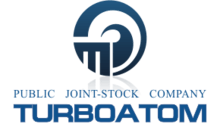Turboatom
 | |
Native name | Турбоатом |
|---|---|
| State-owned enterprise | |
| Industry | Power engineering |
| Founded | 1934 |
| Headquarters | Kharkiv, Ukraine |
| Profit |
|
Number of employees | 4773 (2015) |
| Website |
turboatom |
Turboatom (Ukrainian: Турбоатом) is one of the strategic state-owned enterprises of Ukraine, determining to a considerable degree energy and national security of the state. The plant is among the top ten turbine construction companies in the world, accounting for the global market of power engineering and making real competition to such industrial giants as General Electric, Siemens, Alstom, JSC "Power machines", Andritz Hidro, Voith.
History
1929–1940 Foundation and commissioning
On 1 May 1932, the first stage of the turbogenerator plant was commissioned. Its design capacity was consistent with production of 1.5 million kW per year of steam turbines. Four workshops were put into service: blade, tool, workshop of different parts and workshop of discs and diaphragms.
Achievements in 1932 included:
- First hydroelectric generator for Dzoraget Hydroelectric Power Station
- Diesel-generator set for Turkestan–Siberia Railway
- Renovation of 10 regional power plants and 12 turbines with a total capacity of 134 MW
- Production of turbine blades that previously were imported from abroad
By the end of 1932, development of the first design of a turbogenerator with a capacity of 50 MW was completed. In early 1933, three more workshops were commissioned: large machining, winding and assembly. At the end of the year, production of 24 types of blades was mastered and turbines were refurbished for Kashira Power Plant and some other power plants.
1940–1950 War and Postwar years
The years of The Second World War became a serious test for the plant. The plant suspended production of turbines and began manufacture of defense products, manufactured mortars and repaired tanks. The work at the enterprise was suspended only three days before the beginning of the occupation of Kharkiv on 21 October 1941. Meanwhile, an evacuation process was in full swing. During the evacuation, "Turboatom" was divided into several parts. On 23 August 1943, Kharkiv was freed and rehabilitation of the enterprise began.
A team of turbine constructors restored native plant and manufactured products for the country, and at the same time participated in the restoration of municipal services. In late 1944, the plant already had 374 (out of 700) items of machine tools and other production equipment installed in accordance with the plant rehabilitation project. In a year, 250 machine tools were installed and commissioned. The number of workers and employees of the plant rapidly increased from 876 to 1664 persons in a year.
In 1944 for city of Kharkov were restored and equipped four turbines with total capacity of 68 thousand kW; two turbines with capacity of 22 thousand kilowatt for Kyiv and also erected turbines for Sevastopl, Kaluga and Shterov Power Station total capacity of 28,200 kW.
Achievements in 1944 included:
- Four turbines with a total capacity of 68 thousand kW restored and equipped for the city of Kharkov
- Two turbines with a capacity of 22 thousand kilowatt for Kyiv
- Erection of turbines for Sevastopl, Kaluga and Shterov Power Stations with a total capacity of 28,200 kW
Development of nuclear turbine construction
Turboatom began serial production of turbines MK-30 with a capacity of 30 MW for mining and chemical centers with experimental reactors. The first Kharkov turbine MK-30 was put into operation in December 1958 in Tomsk.
In the early 1970s, manufacture of turbines for nuclear power plants with a capacity of 500 MW was approved. This allowed a sharp reduction in capital expenditure on the construction of power plants. Turbines of this type are installed at:
- Leningrad Nuclear Power Plant (the world's largest)
- Kursk Nuclear Power Plant
- Smolensk Nuclear Power Plant
In the 1970s Turboatom was identified as a leading enterprise in designing and manufacturing powerful steam turbines for nuclear power plants.
In 1982–1985 the company mastered manufacture of steam turbines with a capacity of 1000 MW for the following:
- South Ukraine Nuclear Power Plant
- Kalinin Nuclear Power Plant
- Zaporizhia Nuclear Power Plant
- Balakovo Nuclear Power Plant
- Rostov Nuclear Power Plant
- Kozloduy Nuclear Power Plant (Bulgaria)